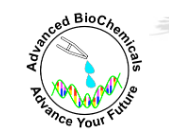
Acrylate PEG NHS Ester (AC-PEG-SCM) from Advanced BioChemicals (ABC) are high quality linear heterobifunctional PEG derivatives with one maleimide group and one succinimidyl carboxyl methyl ester group, which can be used as crosslinkers or spacers between two different chemical reagents. Acrylate can polymerize under UV light or radical initiator to form PEG-hydrogel and SCM group can selectively react with primary amine.
Advanced BioChemicals (ABC) offer AC-PEG-SCM with MW 2kDa, MW 3.5 kDa, MW 5kDa, MW 10kDa and MW 20kDa, in 100mg, 500mg, 1g and 5g packing sizes. Different MW of AC-PEG-SCM products may be available by custom synthesis, please email us at tech@advancedbiochemicals.com for details. Advanced BioChemicals (ABC) also provide repackaging services, please contact us at sales@advancedbiochemicals.com for a free quote.
| MW | 2K, 3.5K, 5K, 10K, 20K |
|---|---|
| Pack Size | 100mg, 500mg, 1g, 5g |
ebiomall.com






>
>
>
>
>
>
>
>
>
>
>
>
这个“类”是什么意思?
多肽和蛋白质类激素(不可口服):促甲状腺激素释放激素,促甲状腺激素,促性腺激素、生长激素,催乳素,胰岛素,胰高血糖素,
氨基酸类衍生物(可口服):甲状腺激素、肾上腺素
脂质类激素:(可口服)性激素和孕激素
蛋白质类激素不能口服,因会被消化液中的蛋白酶分解(——这是原因)
这是我们老师说的哦!!希望对你有帮助
作者、斯坦福大学医学中心的梅斯勒(AnnaH.Messner)和同事解释,有多个研究曾检查了在扁桃体切除手术前使用类固醇类药的情况,但得到的结果不一。据他们在8月《耳鼻喉、头、颈外科文献》(ArchOtolaryngolHeadNeckSurg2004;130:917-921)上发表的论文说,他们对这种病人进行了一项最大的前瞻性、随机、双盲研究。
共219名9个月至12岁的参试者被随机分为或用地塞米松1mg/kg,最大剂量至50mg(n=106),或用安慰剂(n=113)。在药物组中,62人进行的扁桃体切除术采用的是电烧烙法,44人采用的是锐性分离。安慰剂两种方法分别为56人和57人。术后第一天,类固醇组医生评定的Wong-Baker可视模拟量表上的疼痛分平均为4.4,安慰剂组5.3(p<0.001);前组家长评估的疼痛分(p=0.002)和病儿自己评估的疼痛分((p=0.002))也明显更低。类固醇组有1.2次呕吐发作,安慰剂组2.1次(p=0.02),前组也更快地恢复了正常进食(=0.004)。另外,作者还发现,进行锐性分离的病人使用类固醇受益最大,医生和家长评估的疼痛分显著低于电烧烙组。
“我们的研究结果支持在进行扁桃体手术时以1mg/kg的剂量IV地塞米松”,研究者总结。
http://care.diabetesjournals.org/cgi/content/abstract/31/8/1479
OBJECTIVE—Hyperglycemiaisariskfactorformicrovascularcomplicationsandmayincreasetheriskofcardiovasculardiseaseinpatientswithtype2diabetes.ThisstudytestedtheLDLcholesterol–loweringagentcolesevelamHCl(colesevelam)asapotentialnoveltreatmentforimprovingglycemiccontrolinpatientswithtype2diabetesonsulfonylurea-basedtherapy.
RESEARCHDESIGNANDMETHODS—A26-week,randomized,double-blind,placebo-controlled,parallel-group,multicenterstudywascarriedoutbetweenAugust2004andAugust2006toevaluatetheefficacyandsafetyofcolesevelamforreducingA1Cinadultswithtype2diabeteswhoseglycemiccontrolwasinadequate(A1C7.5–9.5%)withexistingsulfonylureamonotherapyorsulfonylureaincombinationwithadditionaloralanti-diabetesagents.Intotal,461patientswererandomized(230givencolesevelam3.75g/dayand231givenplacebo).Theprimaryefficacymeasurementwasmeanplacebo-correctedchangeinA1Cfrombaselinetoweek26intheintent-to-treatpopulation(lastobservationcarriedforward).
RESULTS—Theleastsquares(LS)meanchangeinA1Cfrombaselinetoweek26was–0.32%inthecolesevelamgroupand+0.23%intheplacebogroup,resultinginatreatmentdifferenceof–0.54%(P<0.001).TheLSmeanpercentchangeinLDLcholesterolfrombaselinetoweek26was–16.1%inthecolesevelamgroupand+0.6%intheplacebogroup,resultinginatreatmentdifferenceof–16.7%(P<0.001).FurThermore,significantreductionsinfastingplasmaglucose,fructosamine,totalcholesterol,non–HDLcholesterol,andapolipoproteinBweredemonstratedinthecolesevelamrelativetoplacebogroupatweek26.
CONCLUSIONS—ColesevelamimprovedglycemiccontrolandreducedLDLcholesterollevelsinpatientswithtype2diabetesreceivingsulfonylurea-basedtherapy.









